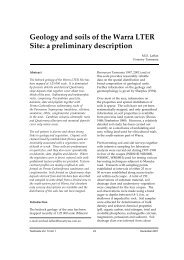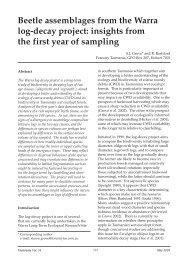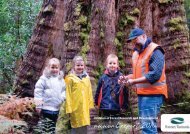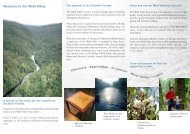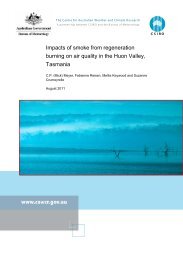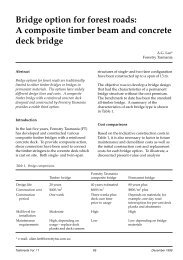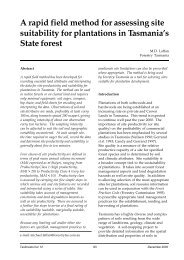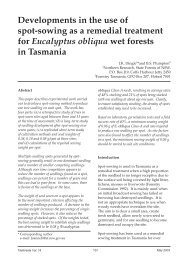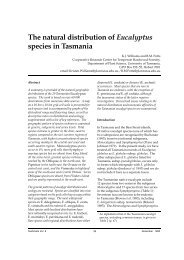sustainable forest management - Forestry Tasmania
sustainable forest management - Forestry Tasmania
sustainable forest management - Forestry Tasmania
Create successful ePaper yourself
Turn your PDF publications into a flip-book with our unique Google optimized e-Paper software.
Non-timber values<br />
Honey production<br />
Most of <strong>Tasmania</strong>’s leatherwood-rich <strong>forest</strong> is located<br />
within the World Heritage Area, and is largely inaccessible<br />
to beekeepers. State <strong>forest</strong>s are therefore an important<br />
resource for the production of leatherwood and other types<br />
of honey. There are currently more than 360,000 hectares<br />
of leatherwood-rich areas in state <strong>forest</strong>s. Where practical,<br />
<strong>forest</strong> <strong>management</strong> prescriptions exclude leatherwood<br />
from harvesting and since 1993, less than three per cent of<br />
leatherwood-rich state <strong>forest</strong>s has been harvested.<br />
Honey production in 2007-2008 was 671,200 kilograms<br />
(Figure 20). Of the 356 sites available, 268 were used,<br />
representing a use rate of 75 per cent, which is lower than<br />
last year’s figure of 84 per cent.<br />
Case Study - Changes to oldgrowth <strong>forest</strong> <strong>management</strong><br />
and the implications for the leatherwood nectar resource<br />
As part of the funding provided under the TCFA for research<br />
into alternatives to clearfelling in oldgrowth <strong>forest</strong>s,<br />
Figure 19. Flowering leatherwood<br />
Hive numbers<br />
<strong>Forestry</strong> <strong>Tasmania</strong> undertook to investigate the effect on the<br />
leatherwood nectar resource of TCFA initiatives to expand<br />
the reserve system and to use mainly variable retention<br />
(non-clearfell) silviculture for tall oldgrowth <strong>forest</strong>s in areas<br />
designated for wood production. This study was developed<br />
and supported through input from representatives of the<br />
<strong>Tasmania</strong>n Beekeepers Association, Forests and Forest<br />
Industry Council, <strong>Tasmania</strong>n Crop Pollinators Association and<br />
the Department of Primary Industries and Water.<br />
The study involved a spatial analysis of photo-interpreted<br />
<strong>forest</strong> type mapping that was used to identify the potential<br />
leatherwood nectar resource in <strong>Tasmania</strong>. This analysis<br />
was applied together with a simulation of planned timber<br />
harvesting over the next 90 years and included clearfell,<br />
group selection within special timber <strong>management</strong> units,<br />
shelterwood and variable retention harvest systems.<br />
Results from this study showed that 1.09 million hectares<br />
of <strong>forest</strong> within <strong>Tasmania</strong> was identified as likely to<br />
contain leatherwood. Of this area, 59.3 per cent occurs in<br />
Figure 20. Honey production and beehive numbers in state <strong>forest</strong>s<br />
12,600<br />
12,400<br />
800,000<br />
700,000<br />
600,000<br />
12,200<br />
500,000<br />
12,000<br />
400,000<br />
11,800<br />
300,000<br />
200,000<br />
11,600<br />
100,000<br />
11,400<br />
0<br />
2002/03 2003/04 2004/05 2005/06 2006/07 2007/08<br />
Honey production (kg)<br />
conservation reserves (managed by DEPHA), 32.9 per cent<br />
in state <strong>forest</strong>s (managed by <strong>Forestry</strong> <strong>Tasmania</strong>), 6.6 per cent<br />
on private land, one per cent on other publicly managed<br />
land and 0.2 per cent on crown land public reserves. Of the<br />
359,000 hectares in state <strong>forest</strong>s, 106,000 hectares (30 per<br />
cent) occurs within areas zoned for wood production.<br />
Of the 1.09 million hectares of <strong>forest</strong> identified as likely to<br />
contain leatherwood, 696,000 hectares (64 per cent) was<br />
identified to be theoretically accessible and it was calculated<br />
that of this area, 251,000 hectares (36 per cent) was used for<br />
beekeeping.<br />
The study showed that under a modelled scenario that<br />
excluded variable retention (i.e if no alternatives to<br />
clearfelling were introduced), the 106,000 hectares of<br />
leatherwood within wood production areas would be<br />
reduced to 37,000 hectares by 2098. This represents a 6.4 per<br />
cent reduction in the total resource area and a 10.0 per cent<br />
reduction in the accessible resource area. On the other hand,<br />
the inclusion of variable retention predicted that the 106,000<br />
hectares of leatherwood within production areas would be<br />
reduced to 62,000 hectares by 2098. This represents a 4.1 per<br />
cent reduction in the total resource area and a 6.4 per cent<br />
reduction in the accessible resource area.<br />
The application of non-clearfelling techniques in oldgrowth<br />
will lessen the reduction of accessible leatherwood from<br />
10 per cent to six per cent over the next 90 years, providing<br />
some assurance to beekeepers that the majority of the<br />
leatherwood will be secure from harvest operations over the<br />
long-term.<br />
Beehive numbers<br />
Honey Production (kg)<br />
29




